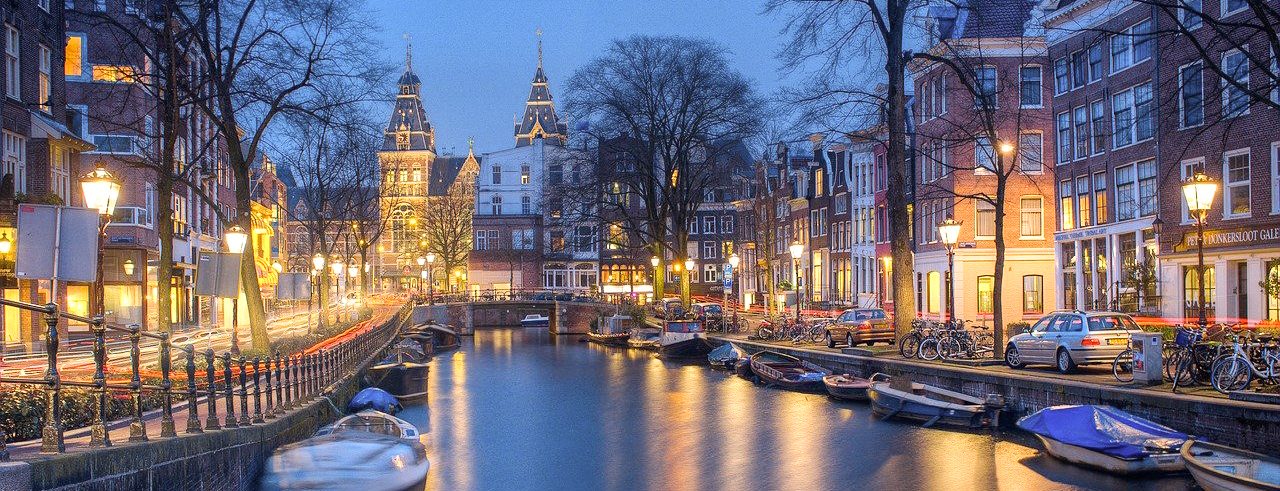The Best, Worst, and Weirdest Things About Hanoi
This post may contain affiliate links. If you make a purchase through these links, we will earn a small commission at no extra cost to you. For more information, please check our privacy policy. Thanks!
During the fall of 2024, Steve and I spent four weeks in Hanoi. Vietnam is the first communist country we have visited and only one of five communist countries in the world (the other four being China, Cuba, Laos, and North Korea). It was our second country in S.E. Asia, and besides the wildly chaotic traffic, we weren’t sure what to expect. Hanoi turned out to be so much more engaging than we expected, and we hope to discover more of its delights in the future.
Read on to find out what we loved, what surprised us, what we didn’t love, and what we did.
All money is in U.S. dollars unless otherwise stated.
A Strange First Day
Our first full day in a new place usually starts with setting up our apartment and grocery shopping. This time, we had a twist. We spent several hours searching for fabric and duct tape to provide bathroom privacy.
Our bathroom had four (yes, four) interior windows. We assume this is to bring light to the inside of the apartment. The bedroom faced the street, and the living area was inside without any windows. The bathroom was between the two.
All the windows had shades, but the one blocking the view of the toilet was a roll-down that also covered the door. Not only was it tedious to roll it up and down, but it was also noisy, so it disturbed the other person’s sleep.
We bought a length of cloth on a street lined with dozens of fabric shops, then hunted for duct tape or something similar. We searched for a few hours, inadvertently ending up on Train Street (more on that below). We were about to give up for the day when we passed a photocopy shop with many rolls of wide blue tape. Here is the result of our efforts:
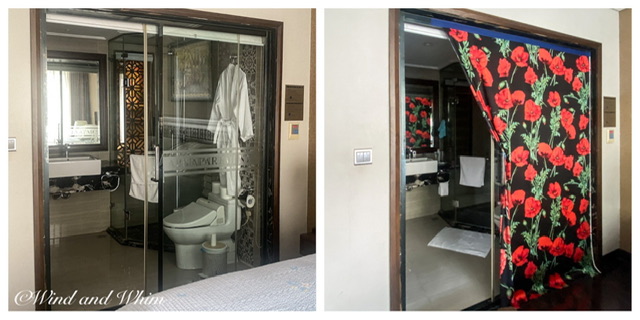
Goods are often sold on specific streets like the street on which we bought fabric. One street we walked down often was lined with bicycle shops. When I wanted to exchange Vietnamese dong for Thai baht, I was referred to Ha Trung Street, where jewelry stores exchange cash but do not advertise it.
Try as we might, we couldn’t find a stationery store. The best we could do was a cluttered shop where we described what we wanted, and the proprietor excavated it.
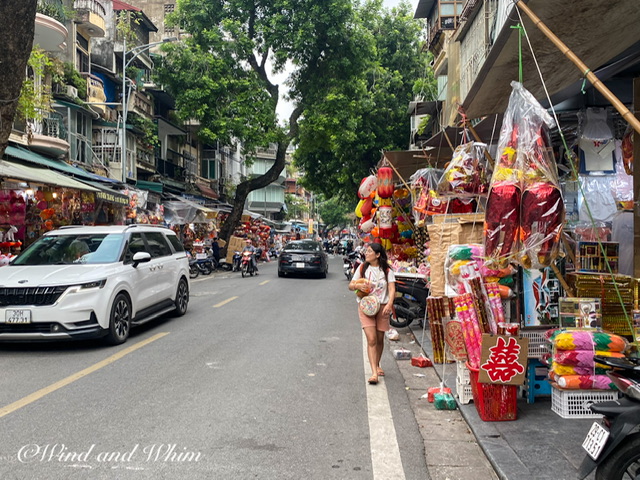
What We Loved
The people
The people of Hanoi impressed us as being friendly, patient, kind, and eager to serve. The restaurant service was the most attentive we’ve ever had without being intrusive.
The first Vietnamese word we learned was xin chao (hello). As we walked down the street, Steve would say it to random people. He always got a smile.
Twice while walking near Hoan Kiem Lake, we were approached by boys and their English instructors. The boys wanted to practice English with us.
As we walked past a school one day, the young students rushed to the gate to see the Americans. The result was a lot of fist bumping through the gate.
And I can’t forget the guard outside our apartment building. He was an older man who was responsible for keeping an eye on the motorcycles parked near the building. He loved Steve and would always pull him aside to talk. He didn’t speak English, and Steve only knew xin chao, but that didn’t stop the guard from chatting away.
Our Airbnb
Our Airbnb game is two for two in S.E. Asia. In Hanoi, we stayed at JB Apartments, and it couldn’t have been better. We had a spacious one-bedroom apartment. It had many amenities, including 24-hour reception, daily cleaning, robes, pajamas, and a washlet. There were even boxes of Kleenex in two places. You’d be surprised at how rare it is to find Kleenex in Airbnbs. All this was only $47 per night.
If you aren’t familiar with washlets, you should be. Many people refer to a washlet as a bidet, but it is much more than a bidet. It’s a bidet seat or a cleaning toilet seat. It’s a bidet on steroids. It goes on the toilet and washes your undercarriage. Some models also dry you.
We first experienced it during a pet sit in the U.S. and I loved it. That one allowed you to adjust the water pressure and water temperature. It also had a heated seat. Both the ones we used were by Toto.
Van Huong hosts this Airbnb in the Hai Ba Trung district. It is a 20-minute walk to Hoan Kiem Lake and just a few minutes more to the Old Quarter.
The food – cheap, tasty, and not spicy
Hanoi was a great place to give our budget some breathing room. In addition to a wonderful apartment at a great price, we had some fantastic meals for a fraction of what we usually pay.
Our previous stop was Kuala Lumpur, where ultra-spicy food is the norm. We don’t like spicy food, so we were pleased that Vietnamese food is not spicy. It was easy to find tasty food without defecting to Mexican cuisine or fish and chips.
One of our first meals was a Korean hot pot buffet at Dookki in the Vincom Center Ba Trieu. It isn’t fancy, but for $12 for both of us, we got a hot pot including meat and vegetables, a buffet with sushi and other tasty treats, and soft drinks. You cook the meat and veggies at your table in either mild or spicy broth.
We also ate at KKUL BBQ twice. For under $30 for two, we had more meat than we could eat, also cooked at our table (this time by an employee), plus salad, rice balls, soup, garnishes, and beverages.
There are several locations in the city. We went to the one on Bui Thi Xuan.
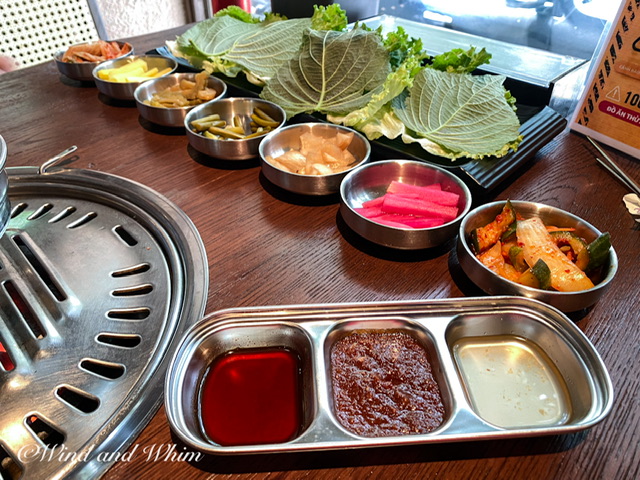
Although most of our meals were a bargain, there were two exceptions. On our first night in the city, we had trouble finding a place to eat. We ended up at a steak house where we were the only customers. We both had salad, filet mignon, and beverages. The meal cost us $80.
Our other pricey meal (by Hanoi standards) was at the Skyline Rooftop Bar. We went there to check out their rooftop bar and take advantage of happy hour. I assumed happy hour was two-for-one drinks. Theirs was three for the price of two. So, we paid full price for my two Margaritas, and Steve got his Coke for free. We had a great meal there, but it cost $76.
You can eat well and inexpensively in Hanoi if you do a better job than we did.
What Surprised Us
The money
We entered Vietnam with more than 7 million Vietnamese dong. Don’t be envious. This was less than $300. The largest note is 500,000 dong, and the smallest is 200 dong. Coins aren’t used in Vietnam.
Keep in mind that a period is used where a comma is used in English-speaking countries. So, 500,000 dong is written as 500.000.
The number of motorcycles and scooters
We knew that there were a lot of motorcycles and scooters in Hanoi that made it difficult to cross the street. What we didn’t anticipate was how many were parked on the sidewalks, sometimes making them impassable.
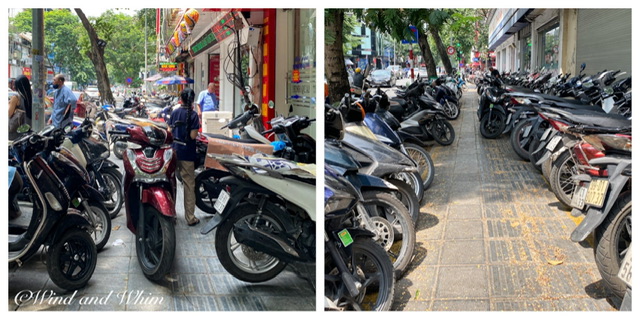
The controlled chaos on the road
Despite the large number of two-wheeled vehicles and the fact that red lights appear to mean “watch out for people crossing the street,” the system works. We saw quite a bit of red-light running in Kuala Lumpur, but in Hanoi, it was rampant. Most cars stopped, but many cycles kept going. When it is your turn to cross, you must assume they will not stop but will avoid you. Otherwise, you will never cross the street.
The attitude towards Americans
The Vietnam War ended almost 50 years ago, which is a long time. Even so, we were amazed that there was no animosity towards us. Quite the opposite, in fact. We were warmly welcomed.
At the Hoa Lo Prison Relic (see below), we talked with a group of young Vietnamese. I asked them if they had relatives who fought in the war. One young man said his grandfather had been a medic in the war and now suffers from PTSD. Even when touching on this sensitive subject, there was no hatred, just an acceptance that that was how things happened.
What We Didn’t Love
The congestion
There are 8.6 million people in Hanoi, and I believe every one of them is either riding a motorbike or parking it on the sidewalk. We could rarely walk down the sidewalk for one whole block without having to go into the street because the sidewalk was blocked by motorbikes and people eating.
Despite this, the streets were exceptionally clean, as they were swept frequently. We also didn’t see any stray dogs, but we did meet several pet dogs.
The weather
The daily highs were from the mid-80s to 90 degrees Fahrenheit or 29 to 32 degrees Celcius, which limited our outdoor sightseeing.
A check of the annual weather shows November through March as having comfortable temperatures and less rain. The downside of visiting during that time is two-fold: pollution in the city, which is already bad, becomes worse and there are more crowds during the height of tourist season (October to February).
The Top Things We Did
Train Street
This is just what it sounds like: a street with train tracks running along it. The street is narrow and lined with buildings. It is only wide enough for a huge and noisy freight train to pass by with a few feet on either side of the tracks. Dozens of cafes fill the lower level of the buildings, and apartments are on top. The locals know the train schedules and use the space on the tracks when it is safe.
Read more about Train Street in this post by Bucketlist Bri.
Ngoc Son Temple in Hoan Kiem Lake
Ngoc Son Temple was built in the early 19th century to honor three sages. It also honors La To, a patron saint of physicians, the scholar Van Xuong, and the military leader Tran Hung Dao.
The Temple is in Hoan Kiem Lake. You reach it by crossing the iconic Huc Bridge. Once there, you can see a lake-front pagoda and visit the temple.
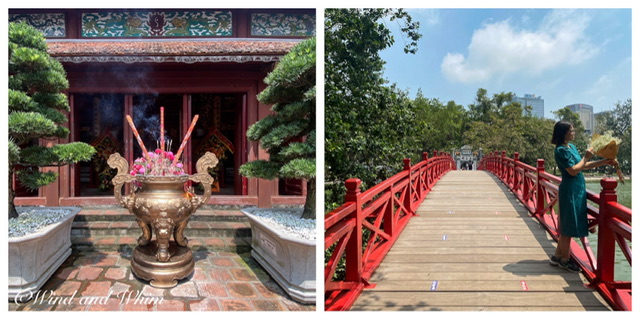
You must buy a ticket at the nearby kiosk before crossing the bright red Huc Bridge to get to the temple grounds. The tickets were only $2 per person.
It was initially named Ngoc Son Pagoda. However, in Vietnamese culture, pagodas are a place to practice Buddhism, while temples are dedicated to the worship of historical figures. Therefore, its name was changed to Ngoc Son Temple soon after construction was completed.
You can learn more about these differences and proper etiquette when visiting temples and pagodas in this article from VietVisionTravel.
Hoa Lo Prison Relic
Steve and I grew up during the Vietnam War, so seeing the Hanoi Hilton was at the top of our list of things to see in Hanoi. Hanoi Hilton was the nickname given to the Hoa Lo Prison by the Americans who were imprisoned there after being shot down by the North Vietnamese.
Neither of us realized this prison had a long, dark history during the decades of the French colonization of French Indochina (1887-1945), which included Vietnam. The French built the prison mainly to house political prisoners. A tour of the museum focuses primarily on this time period. As one would expect, it is full of stories of abuse, torture, and horrendous living conditions.
We were disappointed that of the thirty-five points of interest, only eight pertain to the American War, as the Vietnamese refer to it. There were repeated references to how well the North Vietnamese treated the American prisoners. The prison’s most famous prisoner, the late John McCain, tells a different story, as you can see in this video.
Be sure to get an audio guide. There are plenty of signs in Vietnamese, English, and French, but they won’t tell you very much. The audio guides are twice the cost of the entrance ticket, but both combined only cost 150,000 dong or $6.00.
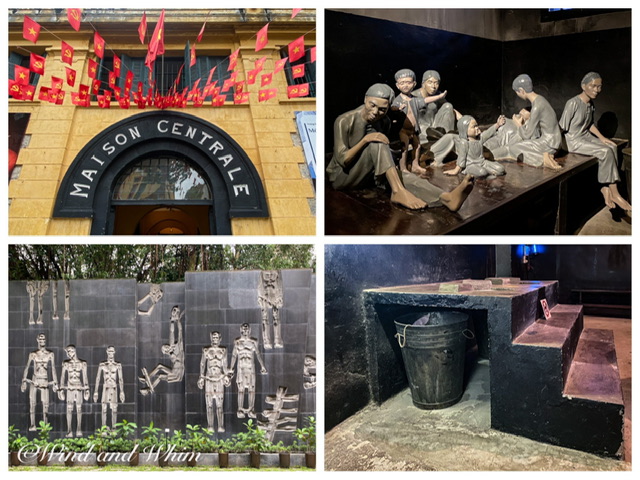
Vietnam National Fine Arts Museum
If you have any interest in fine art, especially if your exposure to it has been primarily European, do not miss the Vietnam National Fine Arts Museum. I may have been inclined to skip it, but thanks to the great reviews from other travelers, Steve and I got to see some fabulous art. And better yet, because of the audio guides, we learned a lot about the art and history of Vietnam.
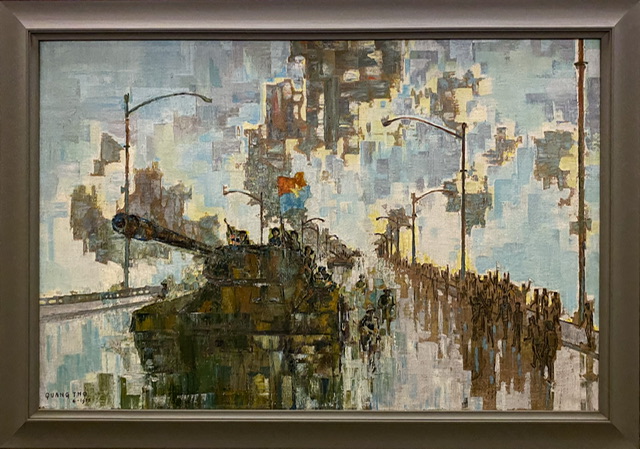
There were many silk and oil on canvas paintings, but the highlight for me was the Vietnamese lacquer paintings. This challenging technique gives paintings a vibrancy not found in oil painting. Unfortunately, this vibrancy doesn’t show in my photos.
Another highlight was the carved wooden displays on the first floor. There are also incredible Buddhist sculptures, including a room dedicated to several Buddhist patriarchs or principal teachers.
The Temple of Literature
You can spend a delightful few hours wandering the grounds of the Temple of Literature as Steve and I did. It was founded in 1070 and dedicated to Confucius. In 1076, it became the first national university in Vietnam, and it continued as such for 700 years.
There are five courtyards, a small museum, and a two-story building. On the first floor of that building were the academy classrooms. There is a place of worship on the second floor.
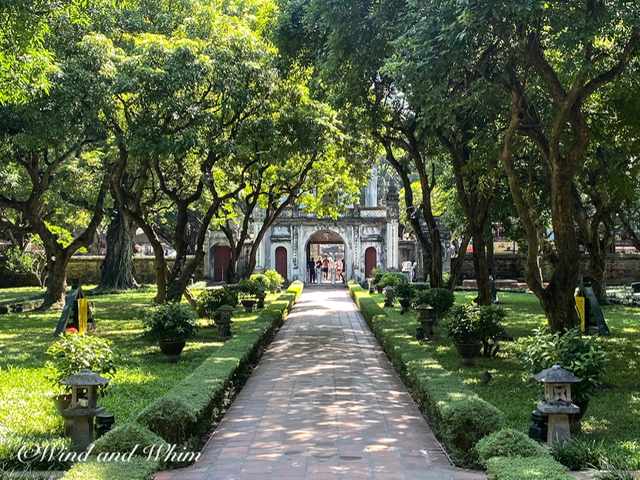
There was an art exhibit of photos of Vietnamese life while we were there. I learned quite a bit from it.
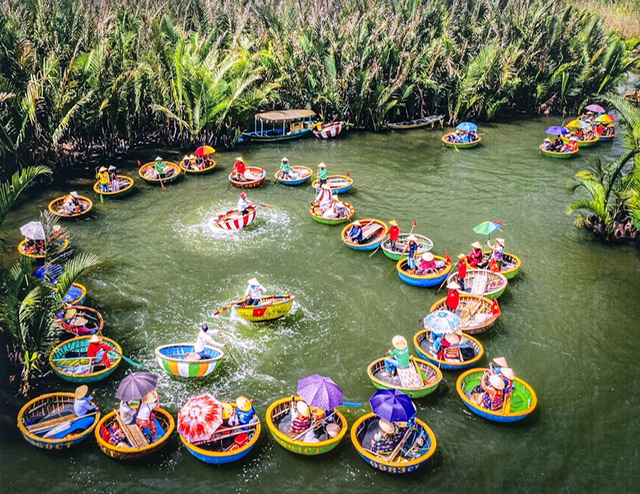
We visited independently, but if we return, I would like to take a tour.
We were allowed in with shorts, but if you want to see the place of worship, you should have your shoulders and knees covered.
Stories from Vietnam War Tour
We took a tour named Stories from Vietnam War at not-to-go-alone areas that we booked through Airbnb. Quang hosts it, although our guide was Kien. It was one of the best tours we’ve taken. There was less focus on the war than on the black market, which exploded after the war, but that was okay.
Kien made the history interesting. He took us to the black-market where in addition to buying cheap goods, stolen goods like car and motorbike accessories. License plates are sometimes stolen from vehicles and resold to their owners. He also took us to the sky market, so-called because the goods sold there are said to have fallen from the sky (like falling off the back of a truck).
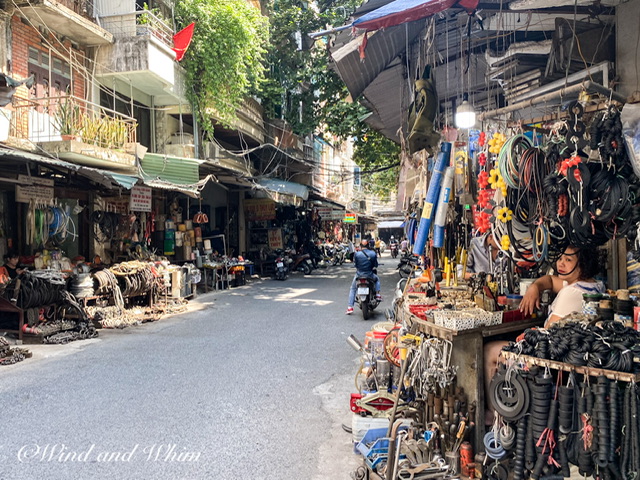
The tour included a stop in a tight-knit neighborhood where shop owners continue to live in what can only be called squalor, even if they are wealthy. They stay in that neighborhood to avoid drawing attention to themselves, but according to Kien, they enjoy their wealth by traveling, having their children educated overseas, and outfitting their apartments with luxuries.
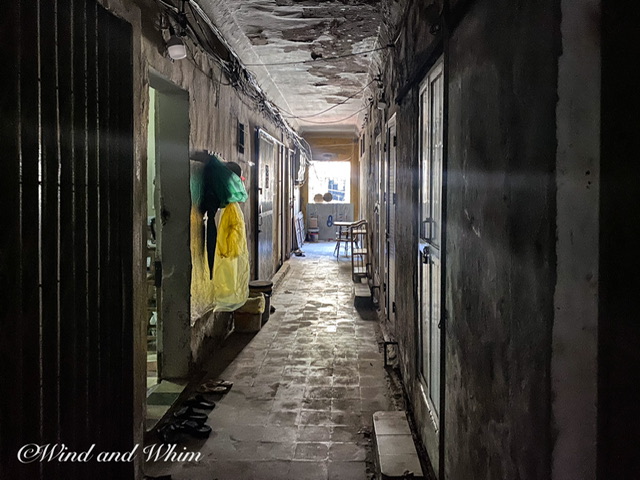
Halong Bay Two-Night Cruise
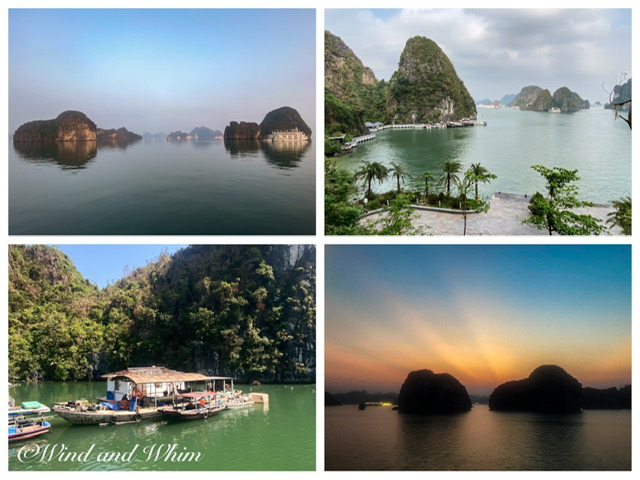
If you find yourself in North Vietnam, please consider doing a Halong Bay Cruise. It was the highlight of our month in North Vietnam.
There are many companies offering one-day, one-night, and two-night cruises.
We chose a two-night cruise and are glad we did. Most of the people on our ship stayed only one night, so they missed a relaxing day on the bay. That was the best part of the cruise.
Our tour involved exploring several caves, one of which was reached by kayak.
There was also a stop at Titov Island, where we could climb stairs to the top for some of the best views in the bay or hang out on the beach.
When we weren’t crawling through caves or climbing a hill, we were being served fabulous food, hanging out on the sun deck, or, in my case, having a couple of wonderful massages. The trip was the perfect blend of nature and luxury.
We sailed on the Paradise Elegance through Halong Bay Tours. The total cost, excluding my massages, was $860. Even though it’s a lot of money, I recommend it to anyone who can afford the extra cost. We got to see and do so much more than people who booked the one-night cruise. The company did a stellar job, and we recommend them.
The One Thing We Skipped
Steve and I decided to skip the Ho Chi Minh Mausoleum Complex because of the requirement that shoulders, arms, and knees must be covered. With the temperatures near 90 degrees daily and having gotten overheated when visiting the Batu Caves in Kuala Lumpur, we decided to skip it for now.
Ho Chi Minh was the president of Vietnam from 1945 to 1969 and fought for Vietnamese independence. He is sometimes called Uncle Ho.
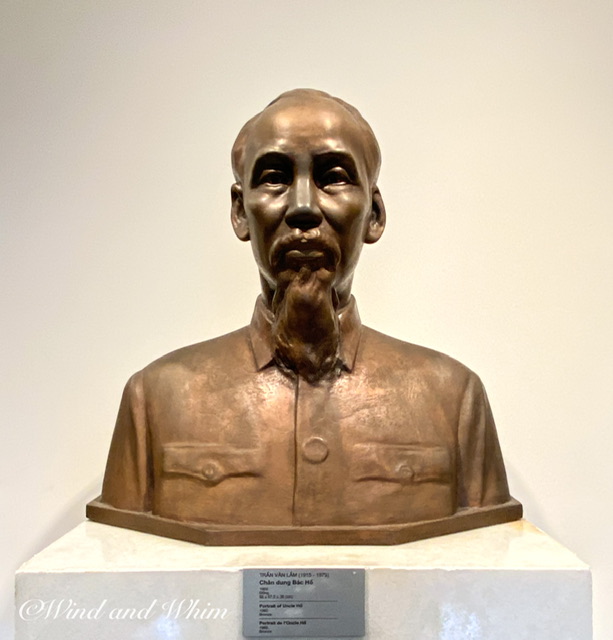
No doubt this complex is worthwhile. In addition to the mausoleum, the complex contains the Presidential Palace, two houses that Ho Chi Minh lived in (he never lived in the Presidential Palace), a museum, a pagoda, and a botanical garden. You can read more about the complex here.
Since we both enjoyed Hanoi and hope to revisit it in cooler weather, this will top our list of things to do.
Our Take on Hanoi
Steve loved Hanoi from day one. He found the fast pace of urban life exhilarating. I, however, took time to warm up to it. Walking anywhere seemed twice as hard as it had to be because of the crazy traffic and the blocked sidewalks.
There are a lot of run-down buildings, often next door to exquisite shops, hotels, and businesses. I found a lot of beauty in Hanoi, particularly around Hoan Keim Lake, but I had to look harder for it than in other cities we’ve been to.
In the beginning, I said, “I don’t love it, and I don’t hate it.” By the time we left, I had come to appreciate its positives.
What We Spent
| IN HANOI: | |
| Accommodations | $1,370 |
| Flight from Kuala Lumpur | 420 |
| Local transportation | 110 |
| Dining | 420 |
| Groceries | 550 |
| Activities | 120 |
| Miscellaneous* | 80 |
| Hanoi total | $3,070 |
| HALONG BAY CRUISE: | |
| Base cost | $760 |
| Drink cost | 60 |
| Massages (1.5 hours) | 80 |
| Tips, transportation to/from bus, snacks on road | 40 |
| Halong Bay cruise total | $940 |
| Grand total | $4,010 |
| Cost per night (28 nights) | $143 |
Until Next Time
Our time in Hanoi left us with many memories and an appreciation for Vietnam and its people. If you’ve been to Hanoi, Steve and I would love to hear about your experiences and thoughts.
Happy traveling,
Linda
Before You Go
If you enjoyed this post, please consider subscribing to Wind and Whim. You’ll get an email notification each time we publish a new post and get our short and sweet monthly newsletter in your inbox, too! If I’ve given you valuable information and you want to show your appreciation, you can buy me a coffee.
